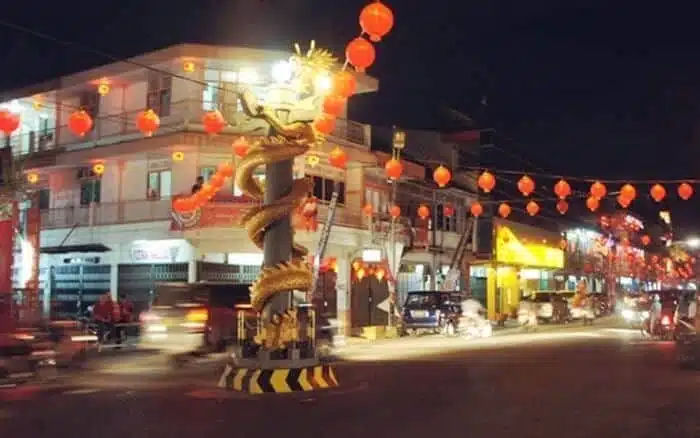The Chinese New Year celebration in Singkawang: exciting traditions and culinary specialties attracts thousands of visitors every year from all over Indonesia and even abroad. Located in West Kalimantan, this city is known for its strong Chinese community and its unique traditional rituals, especially during the Lunar New Year, locally known as Cap Go Meh. In this article, discover why Singkawang is the perfect destination for a cultural experience filled with drums, lion dances, and delicious food.
A Multicultural City with a Chinese Soul
Nicknamed “the little Hong Kong of Indonesia,” Singkawang is home to various ethnic groups: Chinese Hakka, Malays, Dayaks, and others. This cultural diversity makes the Chinese New Year celebration in Singkawang even richer and more spectacular. With over 40% of its population of Chinese descent, it’s no surprise that the Lunar New Year is a major event here.
A Spectacular Event
The Chinese New Year celebration in Singkawang usually begins in late January or early February, based on the lunar calendar. The highlight is Cap Go Meh, celebrated on the fifteenth day of the New Year. The city comes alive with parades, spiritual processions, and traditional dances.
One of the most anticipated events is the Tatung parade. Tatungs are spirit mediums who enter a trance to be possessed by protective deities. Wearing colorful costumes and often pierced by sharp objects, they walk the streets without pain—an impressive and mystical sight.
Lion and dragon dances, accompanied by deafening drums and firecrackers meant to ward off evil spirits, fill the air with excitement.
Living and Ancestral Traditions
What makes the Chinese New Year celebration in Singkawang special is its deep-rooted Hakka heritage. Local families decorate their homes with red lanterns, calligraphy, and ancestral offerings.
Respect for elders, purification rituals, and temple visits are central to the celebration. The Tri Dharma Budi temple is a popular place for worship and ritual ceremonies.
Exceptional Local Cuisine
The Chinese New Year celebration in Singkawang wouldn’t be complete without its mouth-watering dishes. The city is known for its Chinese-Indonesian cuisine—a perfect blend of local spices and traditional recipes.
Here are some must-try dishes:
-
Nasi Campur Singkawang: Rice with roasted meats, eggs, pickled vegetables, and special sauce.
-
Choipan: Steamed dumplings filled with vegetables and served with garlic chili sauce.
-
Bakmi Singkawang: Homemade noodles with char siu pork, chicken, and vegetables.
-
Kue keranjang: Sticky rice cake symbolizing prosperity during Chinese New Year.
Night markets are filled with snack vendors offering a true culinary adventure.
Why Visit Singkawang During Chinese New Year?
Experiencing the Chinese New Year celebration in Singkawang: exciting traditions and culinary specialties lets you immerse yourself in a rich culture and connect with locals in a meaningful way. It’s more than a holiday—it’s a proud expression of identity and heritage.
With festive decorations, warm locals, and vibrant parades, it’s truly one of the best times to visit Singkawang.
Travel Tips
-
When to visit?: Check the lunar calendar—usually between late January and mid-February.
-
Where to stay?: Book early, as hotels fill up quickly.
-
How to get there?: Fly to Pontianak, then travel 4–5 hours by car to Singkawang.
Conclusion
The Chinese New Year celebration in Singkawang: exciting traditions and culinary specialties is more than just an annual event—it’s a rare opportunity to witness the living fusion of culture, spirituality, and gastronomy in one place.
Ready for an unforgettable journey?
Bali Ethnik, your Indonesian travel agency, is here to help you explore Singkawang and the authentic cultures of Indonesia.
Contact us now to plan your personalized trip!





